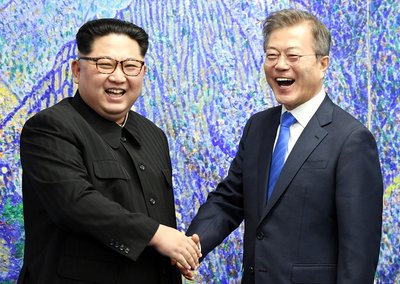 President Moon Jae-in and Chairman Kim Jong Un shake hands during the morning of April 27 at the Panm unjom Peace House. Image: Korea Summit Press Pool |
For the first time in history, a North Korean leader has crossed the military demarcation line and stepped foot into South Korean territory. The North and South produced a joint declaration expressing the will for denuclearization of the Peninsula and a peace plan. The two sides also agreed on measures required for the improvement of inter-Korean relations. This represents an historical step towards the direction of peace on the Peninsula.
But this was just the first step. The proceeding steps need to include Kim Jong Un matching his statements with actions. The fundamental condition to peacefully achieving the denuclearization of the Peninsula is the dismantlement of North Korea’s nuclear weapons. This will be the core agenda item of the upcoming US-North Korea summit meeting.
The North Korean regime has pursued its Byungjin policy of simultaneously developing nuclear weapons and building up the economy. After a rapid succession of missile and nuclear tests in 2016 and 2017, the North claimed that it had become a nuclear power. This was the first phase of the strategy, which was completed at the end of last year. The second phase of the strategy is to move towards a conciliatory atmosphere to convince the international community to relax sanctions so that the North can extract concessions for its economic development. Kim Jong Un marked the initiation of the second phase of the strategy during his 2018 New Year’s Address.
However, if the regime does not give up its nuclear weapons, international sanctions will not be lifted and North Korea’s economic development will continue to stagnate. How can the North address this? Former North Korean diplomat Thae Yong Ho said that North Korea’s leadership previously intended to trade away its nuclear weapons, but the international community lost interest so it naturally changed tack and decided to become a nuclear power. It thus decided to follow the model of Pakistan and India in devising its strategy.
If Kim Jong Un is trying to use the inter-Korean and US-North Korea summits to advance the second phase of its Byungjin strategy, success may prove elusive. South Korea, the international community, and the North Korean people are all waiting for North Korea to give up its nuclear weapons and focus on economic development. This is what will open up a new era of peace on the Korean Peninsula.
North Korea pledged to cease nuclear tests and shut down its Yongbyon facility, but this by itself is insufficient. A full inventory must be sent to the IAEA detailing all of the country’s nuclear weapons, nuclear material, storage facilities, equipment for uranium enrichment, reprocessing equipment for plutonium production, test sites, vehicles, and missile production facilities. A full inspection must then be carried out. Only after this has occurred can all international sanctions be lifted.
Second, North Korea’s political prison camps need to be shut down. The fundamental spirit of peace is respect for human life. Tens of thousands of North Koreans are held in these prisons. How can we trust the North’s claim that it respects peace and the sanctity of human life when tens of thousands of North Koreans are left to languish in these prisons?
The biggest item of anticipation with regards to the inter-Korean and US-North Korea summit is the change we see in the regime’s actions. It is my sincere hope that Kim Jong Un realizes the importance of establishing peace on the Peninsula by opening up to South Korea and the international community, and then commits to denuclearization.




















